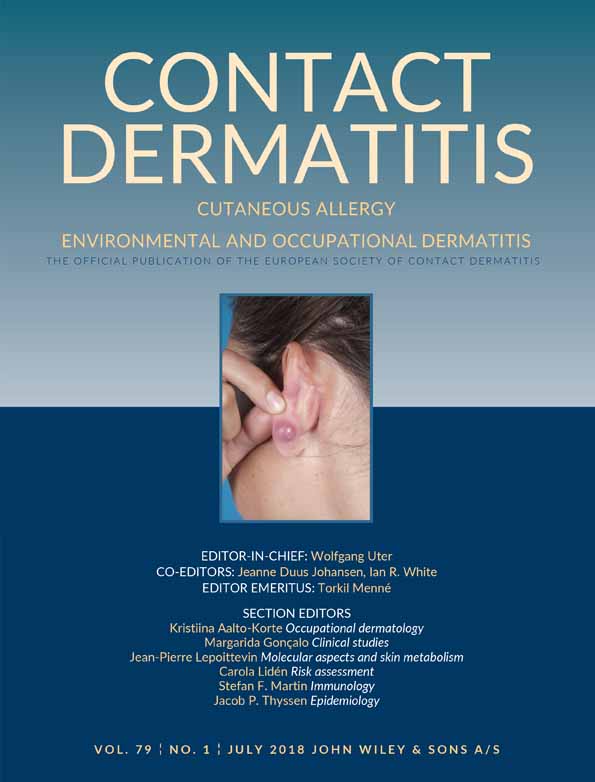Is a high concentration of hexavalent chromium in Indian cement causing an increase in the frequency of cement dermatitis in India?
Corresponding Author
Kaushal K. Verma
Department of Dermatology and Venereology, All India Institute of Medical Sciences, New Delhi, India
Correspondence
Kaushal K. Verma, Department of Dermatology and Venereology, All India Institute of Medical Sciences, New Delhi 110029, India.
Email: [email protected]
Search for more papers by this authorErik Zimerson
Lund University, Skane University Hospital, Department of Occupational and Environmental Dermatology, Malmö, Sweden
Search for more papers by this authorMagnus Bruze
Lund University, Skane University Hospital, Department of Occupational and Environmental Dermatology, Malmö, Sweden
Search for more papers by this authorMalin Engfeldt
Lund University, Skane University Hospital, Department of Occupational and Environmental Dermatology, Malmö, Sweden
Search for more papers by this authorCecilia Svedman
Lund University, Skane University Hospital, Department of Occupational and Environmental Dermatology, Malmö, Sweden
Search for more papers by this authorMarléne Isaksson
Lund University, Skane University Hospital, Department of Occupational and Environmental Dermatology, Malmö, Sweden
Search for more papers by this authorCorresponding Author
Kaushal K. Verma
Department of Dermatology and Venereology, All India Institute of Medical Sciences, New Delhi, India
Correspondence
Kaushal K. Verma, Department of Dermatology and Venereology, All India Institute of Medical Sciences, New Delhi 110029, India.
Email: [email protected]
Search for more papers by this authorErik Zimerson
Lund University, Skane University Hospital, Department of Occupational and Environmental Dermatology, Malmö, Sweden
Search for more papers by this authorMagnus Bruze
Lund University, Skane University Hospital, Department of Occupational and Environmental Dermatology, Malmö, Sweden
Search for more papers by this authorMalin Engfeldt
Lund University, Skane University Hospital, Department of Occupational and Environmental Dermatology, Malmö, Sweden
Search for more papers by this authorCecilia Svedman
Lund University, Skane University Hospital, Department of Occupational and Environmental Dermatology, Malmö, Sweden
Search for more papers by this authorMarléne Isaksson
Lund University, Skane University Hospital, Department of Occupational and Environmental Dermatology, Malmö, Sweden
Search for more papers by this author
REFERENCES
- 1Winder C, Carmody M. The dermal toxicity of cement. Toxicol Ind Health. 2002; 18: 321-331.
- 2Directive 2003/53/EC of the European Parliament and of the Council of 18 June 2003 amending for the 26th time Council Directive 76/769/EEC relating to restrictions on the marketing and use of certain dangerous substances and preparations (nonylphenol, nonylphenol ethoxylate and cement). Off J Eur Union. 2003: p. L178/24-27.
- 3Geier J, Krautheim A, Uter W, Lessmann H, Schnuch A. Occupational contact allergy in the building trade in Germany: influence of preventive measures and changing exposure. Int Arch Occup Environ Health. 2011; 84: 403-411.
- 4Mowitz M, Zimerson E, Hauksson I, Pontén A. Chromate and amine contact allergies in workers manufacturing precast concrete elements. Contact Dermatitis. 2016; 75: 363-369.
- 5Erdem E, Donat R, Esen K, et al. Removal of soluble Cr[VI] in cements by ferrous sulphate monohydrate, solid lignin and other materials. Ceramics Silikat. 2011; 55: 85-93.
- 6Fregert S. Chromium valencies and cement dermatitis. Br J Dermatol. 1981; 105(suppl 21): 7-9.
- 7Goh CL, Kwok SF, Gan SL. Cobalt and nickel content of Asian cement. Contact Dermatitis. 1986; 15: 196-172.




